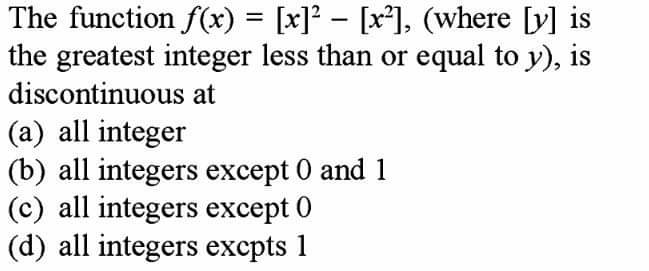Question Number 85871 by M±th+et£s last updated on 25/Mar/20

Commented by Rio Michael last updated on 25/Mar/20

$$\mathrm{all}\:\mathrm{integers} \\ $$
Commented by mr W last updated on 25/Mar/20
![all integers except 1. x=1+δ f(x)=[1+d]^2 −[(1+d)^2 ] lim_(x→1^+ ) f(x)=lim_(δ→0) {[1+d]^2 −[(1+d)^2 ]}=1−1=0 x=1−δ f(x)=[1−d]^2 −[(1−d)^2 ] lim_(x→1^− ) f(x)=lim_(δ→0) {[1−d]^2 −[(1−d)^2 ]}=0−0=0 f(1)=1−1=0 lim_(x→1^− ) f(x)=lim_(x→1^+ ) f(x)=f(1) ⇒continuous at x=1](https://www.tinkutara.com/question/Q85893.png)
$${all}\:{integers}\:{except}\:\mathrm{1}. \\ $$$${x}=\mathrm{1}+\delta \\ $$$${f}\left({x}\right)=\left[\mathrm{1}+{d}\right]^{\mathrm{2}} −\left[\left(\mathrm{1}+{d}\right)^{\mathrm{2}} \right] \\ $$$$\underset{{x}\rightarrow\mathrm{1}^{+} } {\mathrm{lim}}{f}\left({x}\right)=\underset{\delta\rightarrow\mathrm{0}} {\mathrm{lim}}\left\{\left[\mathrm{1}+{d}\right]^{\mathrm{2}} −\left[\left(\mathrm{1}+{d}\right)^{\mathrm{2}} \right]\right\}=\mathrm{1}−\mathrm{1}=\mathrm{0} \\ $$$${x}=\mathrm{1}−\delta \\ $$$${f}\left({x}\right)=\left[\mathrm{1}−{d}\right]^{\mathrm{2}} −\left[\left(\mathrm{1}−{d}\right)^{\mathrm{2}} \right] \\ $$$$\underset{{x}\rightarrow\mathrm{1}^{−} } {\mathrm{lim}}{f}\left({x}\right)=\underset{\delta\rightarrow\mathrm{0}} {\mathrm{lim}}\left\{\left[\mathrm{1}−{d}\right]^{\mathrm{2}} −\left[\left(\mathrm{1}−{d}\right)^{\mathrm{2}} \right]\right\}=\mathrm{0}−\mathrm{0}=\mathrm{0} \\ $$$${f}\left(\mathrm{1}\right)=\mathrm{1}−\mathrm{1}=\mathrm{0} \\ $$$$ \\ $$$$\underset{{x}\rightarrow\mathrm{1}^{−} } {\mathrm{lim}}{f}\left({x}\right)=\underset{{x}\rightarrow\mathrm{1}^{+} } {\mathrm{lim}}{f}\left({x}\right)={f}\left(\mathrm{1}\right) \\ $$$$\Rightarrow{continuous}\:{at}\:{x}=\mathrm{1} \\ $$
Commented by M±th+et£s last updated on 25/Mar/20

$${thank}\:{you}\:{so}\:{much}\:{sir} \\ $$
